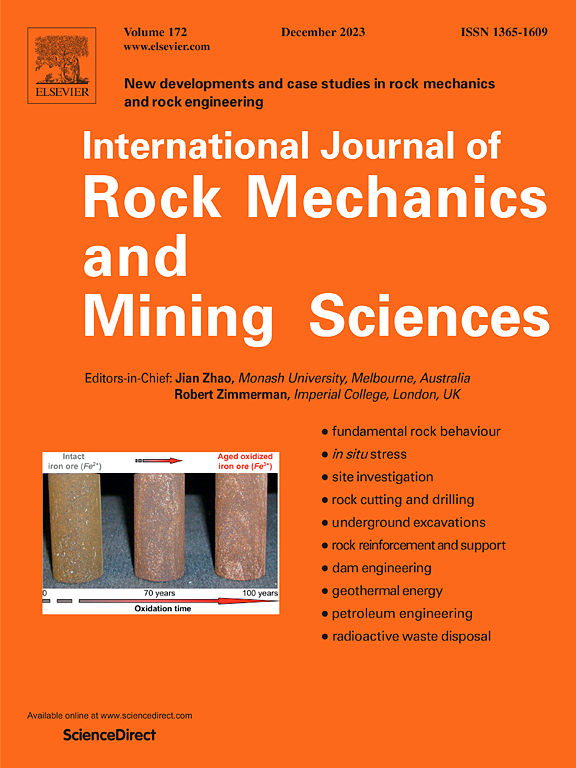A fault activation-shearing-sliding peridynamic model exploring the role of static and kinetic frictional contacts
IF 7
1区 工程技术
Q1 ENGINEERING, GEOLOGICAL
International Journal of Rock Mechanics and Mining Sciences
Pub Date : 2024-10-28
DOI:10.1016/j.ijrmms.2024.105946
引用次数: 0
Abstract
Understanding fault dynamics is essential for comprehending the underlying mechanisms of seismic events. This study introduces a novel fault activation-shearing-sliding model within a peridynamic (PD) framework, characterized by distinctly defined static and kinetic frictional behaviors. Static friction bonds are developed to sustain normal forces perpendicular to the fault plane and to manage tangential frictional forces along the fault's geometry. The failure of these bonds is directly linked to fault activation, while the ensuing sliding phase is governed by a short-range kinetic friction model. Additionally, an adaptive identification method is proposed to accurately determine local unit normal vectors on arbitrarily shaped contact surfaces. The effectiveness and applicability of the model are validated through fault activation and plate sliding friction tests. The model is further utilized to investigate the effects of local geometry, roughness, and friction coefficients on fault behavior, with comparisons to experimental results. Observations indicate that the dominant factors influencing fault shear resistance vary across stages, primarily involving static friction during activation, compaction deformation during shearing, and kinetic friction during sliding. When shear resistance is primarily governed by friction, it exhibits heightened sensitivity to various shear forces, including those from indirect loading disturbances.
探索静态和动态摩擦接触作用的断层激活-剪切-滑动周向动力学模型
了解断层动力学对于理解地震事件的基本机制至关重要。本研究在周动力(PD)框架内引入了一种新的断层激活-剪切-滑动模型,该模型以定义明确的静摩擦和动摩擦行为为特征。静摩擦键的作用是维持垂直于断层平面的法向力,并管理沿断层几何形状的切向摩擦力。这些粘结的失效与断层激活直接相关,而随后的滑动阶段则由短程动摩擦模型控制。此外,还提出了一种自适应识别方法,用于精确确定任意形状接触面上的局部单位法向量。通过故障激活和板滑动摩擦试验,验证了模型的有效性和适用性。该模型还进一步用于研究局部几何形状、粗糙度和摩擦系数对故障行为的影响,并与实验结果进行比较。观察结果表明,影响断层抗剪能力的主要因素在不同阶段各不相同,主要涉及激活过程中的静摩擦、剪切过程中的压实变形和滑动过程中的动摩擦。当抗剪性主要受摩擦力支配时,它对各种剪切力(包括间接加载扰动产生的剪切力)表现出更高的敏感性。
本文章由计算机程序翻译,如有差异,请以英文原文为准。
求助全文
约1分钟内获得全文
求助全文
来源期刊
CiteScore
14.00
自引率
5.60%
发文量
196
审稿时长
18 weeks
期刊介绍:
The International Journal of Rock Mechanics and Mining Sciences focuses on original research, new developments, site measurements, and case studies within the fields of rock mechanics and rock engineering. Serving as an international platform, it showcases high-quality papers addressing rock mechanics and the application of its principles and techniques in mining and civil engineering projects situated on or within rock masses. These projects encompass a wide range, including slopes, open-pit mines, quarries, shafts, tunnels, caverns, underground mines, metro systems, dams, hydro-electric stations, geothermal energy, petroleum engineering, and radioactive waste disposal. The journal welcomes submissions on various topics, with particular interest in theoretical advancements, analytical and numerical methods, rock testing, site investigation, and case studies.

 求助内容:
求助内容: 应助结果提醒方式:
应助结果提醒方式:


